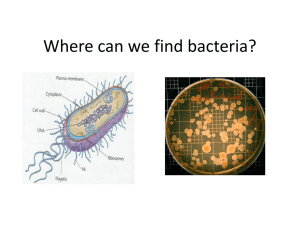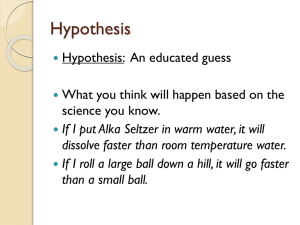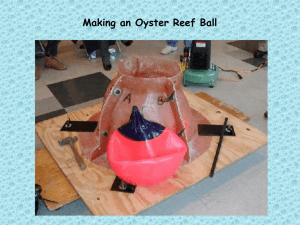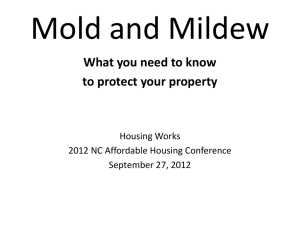Mold Awareness - Ringling College of Art and Design
advertisement
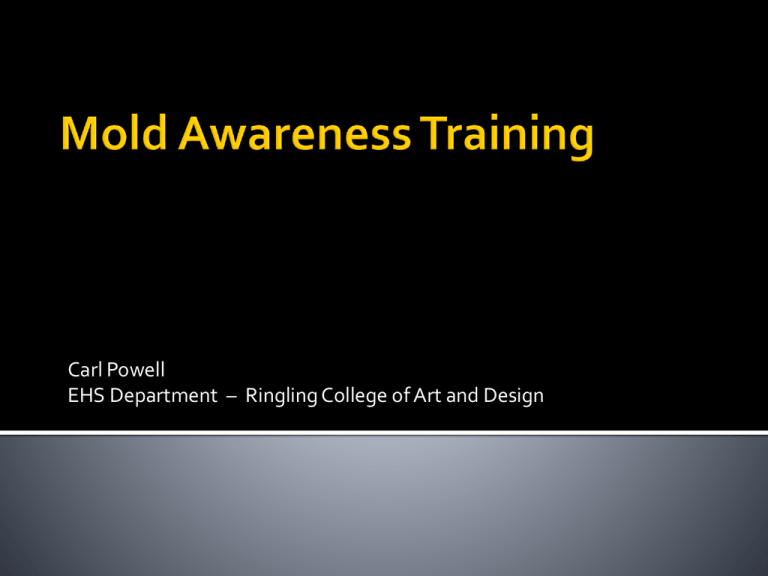
Carl Powell EHS Department – Ringling College of Art and Design This training course will acquaint you with why and how mold forms in buildings. It will explore simple ways to prevent and correctly respond to water losses and mold issues when they occur. The basic science of mold Common causes of water intrusion and mold in buildings Water intrusion prevention practices Responding to water intrusion issues Mold investigations and remediation Mold is a fungus, not a bacteria - they are very different organisms. Fungi survive by absorbing nutrients from their immediate environment. More than 100,000 identified species of fungi exist in our environment. Mold is a term used to classify a group of microscopic fungi that grow in the form of multi-cellular filaments called hyphae. Molds are ubiquitous (found everywhere) in the environment, both indoors and outdoors. When a spore is released by its “flower” or “fruit”, called sporangia, and finds a favorable place to grow, the spore will “blossom” or germinate and begin to produce hyphae. As the hyphae begin to grow, they branch out and interconnect, forming a group called a mycelium. The mycelium will continue to grow and spread across the surface of the food source, be it bread or moist drywall. At this point, most molds are visible to the naked eye, and can be called a mold colony. After the hyphae grow awhile, new spores or “seeds” will form and be released, those spores will germinate, and the whole life cycle repeats again. While molds are capable of growth in just about any environment, they are limited by one crucial factor, moisture. When sufficient moisture is present mold spores can germinate and begin to grow in as little as 24 to 48 hours after becoming moist enough. While many mold spores require direct contact with water to germinate, some molds only need elevated humidity to grow. The good news is if the water or humidity problem is repaired and the moist or wet building materials are dried quickly, mold can be prevented quite easily. This is why water intrusion issues must be treated as an emergency and addressed quickly by connecting the source of the moisture. While moisture and water are the critical elements for mold growth, it is the presence of cellulose-based food that really causes it to thrive and spread. Building materials that provide good cellulose-based food sources include: 1. Drywall, regardless of the type of backing 2. Acoustical ceiling tile 3. Plywood, particle-board and oriented strand board (OSB) 4. Loose fill insulation Not all materials are “good food sources”. But if dust, dirt or debris become trapped in a material, such as carpet or fiberglass insulation, mold growth can occur. With the addition of moisture, the dust, dirt or debris can be an ample food source and can result in mold growth. Ventilation While mold requires both food and moisture to thrive, it does not require good ventilation. In fact, mold prefers areas where ventilation is minimal such as inside wall and ceiling cavities. Trapped Moisture Mold also grows below sub-floors and behind any kind of vapor barrier, including floor and wall coverings like wallpaper. When water resistant wall coverings are applied, especially along exterior walls, it prevents the wall from “breathing”. If this happens, moisture becomes trapped between the drywall system and the wall covering, and mold can easily result. Duration The amount of time that moisture stays in contact with building materials, their food source is another key mold growth factor. The longer the duration, the greater the likelihood that mold will grow. This is why the slow leak that goes unnoticed for sometime may be more likely to result in mold growth than a fl0oding situation where response is more immediate. Sources of water in a building can be both internal and external. Water intrusion events can occur throughout all phases of the construction process, after construction is complete, and while the building is occupied. Internal Internal sources of water can include… Plumbing leaks Sewer issues HVAC issues Humidity Internal- Plumbing Leaks This photo shows a plumbing leak that went unnoticed and unaddressed for some time causing substantial damage. Repair leaky plumbing, sewer leaks, sewer backups, and HVAC leaks as soon as possible. This will save time and money in the long run. Internal- High Humidity This photo is an example of how excessive humidity promoted mold growth on the surfaces of several books. High humidity is often not as obvious as a plumbing leak; however, areas subjected to consistent high humidity can become moist enough to support mold growth. Relative humidity above 60% will readily support mold growth. Ideally, indoor relative humidity levels should be kept between 30 and 50% if possible. External Some of the most common external sources of moisture include: Building envelope penetrations Equipment exhaust vents Negative building pressure Issues with stucco Landscape and getting grade problems Flooding events External – Building Envelope Penetrations A building’s primary barrier for water intrusion prevention is what is referred to as its “ continuous building envelope”. The greatest risks of water intrusion through the continuous building envelope occur at transition and integration points, such as at windows / siding transitions (such as the skylight depicted in this photo) as well as plumbing points like hose bibbs and any other penetrations or breaks in the “envelope”. External – Building Envelope Penetrations Ensuring appropriate and effective sealing of transition and integration points, both into and out of the building envelope, will reduce water intrusion or moisture buildup. External – Equipment Exhaust Vents Any vents that exhaust warm, moist air from any mechanical equipment or appliances should be a minimum of 12 inches off the ground to avoid buildup of condensation on surrounding building materials. External – Negative Building Pressure Negative building pressure results when an HVAC system inside a building draws in more air from the outside than it expels through the supply ducts. A building either can be entirely under negative pressure, or only have certain zones of negative pressure. When buildings operate under negative pressure, some air must be introduced from outside to balance the difference in pressure. Ideally this air enters the HVAC unit through a valve or duct and is dehumidified before being introduced to the indoor environment . External – Negative Building Pressure Unfortunately, negative air pressurization often results in air being sucked in around doors and windows, through cracks in the foundation, and through other penetrations in the building envelope. When this occurs, the outside air is not dehumidified before entering the indoor environment. Overtime, the indoor relative humidity will increase, potentially causing condensation and mold growth on cool interior surfaces or inside walls. External – Windows, Doors, and Roofing One of the most common causes of the water intrusion and air leakage is from windows and doors. Leaking windows and doors allow air and moisture to enter the building. If the problem is not properly diagnosed and repaired, this can result in mold growth, as well as deterioration of building and finish materials. External – Windows, Doors, and Roofing Likewise, roofs are a major source of water intrusion. The majority of roof leaks occur in locations where a continuous portion of the roof meets the ridge or another intersecting angle, wall or other penetrations. Proper flashing at all these locations is critical. External – EIFS Issues Exterior Insulation and Finish System (EIFS) is a building product that provides exterior walls with an insulated finished surface and waterproofing in an integrated composite material system. EIFS is a lightweight synthetic wall cladding that includes foam plastic insulation and thin synthetic coatings. It can be considered the “shell” of a building. EIFS is not stucco. Stucco Traditional stucco, otherwise known as Portland Cement Plaster, is a non- insulating material used for cosmetic purposes, not protection. Since stucco is not meant to be a true moisture barrier, it is critical to verify proper installation of the chosen exterior membrane prior to applying stucco. Exterior – Landscape Issues Proper site grading and drainage are important to prevent moisture intrusion and resulting mold growth in buildings. If surface water is directed towards the building or trapped against the foundation wall, moisture may enter the structure, such as what happened in the residential building depicted in this photo. Exterior – Landscape Issues Intruding moisture may raise the relative humidity of the building, also encouraging mold growth. Actions that can be taken to keep surface water from affecting buildings include: Installing well-maintained gutters with downspouts that discharge at least six feet from the building foundation. Grading the soil near the foundation to ensure the proper slope to direct water away from the building. Keeping vegetation away from the building perimeter. Eliminating mulch or organic debris against the foundation walls, on the roof or in the gutters that might trap and hold moisture. Ensuring that the landscape irrigation system does not spray the building. Exterior – Floods Flooding events can occur during severe weather such as hurricanes. As shown in the photo, widespread damage and fungal growth commonly occur after these natural disasters. The College’s Field Service Manager will inspect the campus after a severe weather event. Prevention Preventing water intrusions is far simpler and less costly than addressing water intrusion problems and the potential ensuring mold. Opportunities to prevent water intrusion begin during the design and project planning process, occur throughout the construction phase, and continue throughout the life of a building’s operation and maintenance. Prevention Most of the construction – related errors that can leave a building vulnerable to water intrusion result from one or more of the following issues: Improper installation Improper design and specifications Improper storage of building materials Improper job sequencing Improper Installation Incorrect installation of moisture-control assemblies is a frequent cause of water intrusion. This photo depicts an improperly flashed and improperly sealed window. Improper Design & Specifications Another frequent culprit is improper building design or component/ system specifications, including simply selecting the wrong product for moisture- sensitive applications. This photo shows the improper use of an exterior sheathing product in a shower stall as the first line of defense against moisture intrusion. Improper Storage of Building Materials This photo shows mold growth on drywall that was not stored properly on the jobsite, became wet, and was subsequently installed and painted. The drywall should have been discarded, or thoroughly dried out within 24 hours. Lumberyard Mold Lumberyard mold is the black staining commonly seen on lumber during the construction processes or on stacks of lumber in lumber yards. Although the black staining may be visually unappealing, studies have shown that they do not cause structural damage to the lumber. Improper Sequencing Improper job sequencing often leads to critical moisture-prevention components being overlooked. At the jobsite in this photo, the bathroom tile was installed before the water-proofing contractor could apply the required liquid membrane product. Prevention The Operations & Maintenance (O&M) plan should focus on careful maintenance of the systems and assemblies most commonly associated with water intrusion issues, which include: HVAC systems Plumbing systems Window and door assemblies Roofing systems Preventive Maintenance - HVAC Systems HVAC systems are essential to keep building occupants comfortable. Unfortunately, they are also the primary conduct and vehicle for the distribution of airborne fungal spores present anywhere in the building. Preventive Maintenance - HVAC Systems HVAC systems are especially favorable to mold growth because they draw air (usually loaded with fungi and moisture) into a building where there are ample food sources for mold to flourish. Fungal growth within the HVAC system itself can rapidly spread mold spores throughout the entire zone or building. Therefore, any visible fungal growth found in any operational HVAC system needs to be addressed immediately. Preventive Maintenance – HVAC Systems HVAC systems can be complex, and a properly designed system takes into account space utilization, number of occupants, and square footage. All airhandling units should be operating properly and protected from outside elements including pollutants and birds. To ensure a HVAC system is in compliance, it should be evaluated against the American Society of Heating, Refrigerating, and Air – Conditioning Engineers (ASHRAE) Standards. Preventive Maintenance – Plumbing Systems Because plumbing leaks are so common, all accessible plumbing components such as pipes, fitting, and valves, should be inspected regularly for signs of leaking, corrosion, or other evidence of water intrusion. Exterior plumbing assemblies such as irrigation systems, fountains, pools, and exposed pipes should also be routinely inspected and tested. If evidence of leaking is found, take immediate action to address the water issue before mold develops. Preventive Maintenance – Windows & Doors All interior and exterior wall systems and finishes should be inspected regularly for signs of water intrusion. Pay special attention to windows and doors and all related components to ensure they are in good condition and working properly. Any suspect conditions such as warping, bubbling, or staining as shown in the photo should be noted and promptly investigated. If water intrusion sources are identified, the causes should be successfully repaired and the damaged components should be either cosmetically repaired or removed and replaced. Preventive Maintenance - Exterior Trim & Siding Wood trim, window frame connections and exterior fixtures should be periodically inspected, caulked and painted, as needed. Exterior Insulation and Finish System (EIFS) should be carefully inspected to ensure penetrations and gaps are not in contact with the soil or vegetation. Verify drainage EIFS are functioning property. Properly seal any entry points to prevent water intrusion. In the case of stucco, cracks less than 1/8” should be patched using a compatible caulking. Cracks greater than 1/8” should be investigated to determine the cause and an appropriate repair should be made. Preventive Maintenance – Roofing Systems Roofing products have a service life and should not be used beyond that point. Service life may be reduced by weather conditions, building design, and maintenance. At a minimum, roof covers should be inspected by knowledgeable maintenance personnel, or a qualified inspection firm, one year after re-placement and every year thereafter. The most important steps to take in response to a water intrusion/water loss are: Shut off the water, if possible Secure the safety of all occupants Identify and repair the cause or source of water Determine if visible mold is present If visible mold is present: Notify the Field Services Manager to initiate the Water Response and Mold Prevention Program. If the affected area is small (<10 sq. ft), maintenance personnel may perform the dry out and clean up procedure. If the area is greater than 10 sq. ft, a subcontractor will need to be contracted. Recognizing the presence of mold is not always obvious, especially when you can’t see it. The following situations or conditions may indicate that hidden mold is present: Musty or damp odors are noticeable in the area Building conditions favorable to mold growth are present, such as condensation and high humidity Porous or semi-porous building materials, especially cellulose-based materials, are noticeably moist or wet in the area of concern Building materials in the impacted area have been wet for 24 to 48 hours or more Evidence of previous moisture problems such as staining, cracking, and warping is observed Additional situations or conditions that may indicate that there is a hidden mold problem include: Relative humidity levels in the building have been greater than 60% for extended periods The HVAC filters or flex duct have become wet Proper maintenance is lacking Occupants have complained about indoor air quality, odors, and health symptoms Water intrusion or mold problems have previously occurred in the same areas Water Staining Water staining is not mold. However, water staining can indicate a leak or water intrusion has occurred. Since moisture is the critical element for mold growth, the staining may be a precursor, particularly in unventilated areas that are not visually assessable. If mold is observed or suspected, it is important to investigate and remediate the situation in an appropriate manner. However, it is important that you: DO NOT open up wall cavities or concealed areas where mold may be growing without first containing the area. DO NOT use fans or other “air moving” devices in the affected areas. DO NOT remove impacted items before containment area(s) are established. HVAC vents are sealed (if possible) and personal protection is worn. DO NOT remove building materials that may contain asbestos or lead paint without an assessment and testing. Not every water intrusion or loss results in mold nor do they require elaborate precautionary actions. Facilities personnel can perform water intrusion clean-up work provided that the following are true: Only clean water was involved No visible mold is present The source of the moisture has been identified and fixed The event is less than 24 hours old The impacted area is clearly delineated and clean up efforts are limited If any of these conditions are not true, it may be necessary to bring in a qualified environment consultant to assist. Microbial investigations often consist of the following tasks: Visual inspection Moisture measurements of building materials Sampling or testing (air, bulk, surface) Use of other specialized equipment such as infrared imaging cameras, bore scopes, etc. Although over 100,000 species of molds have been identified, if its generally not necessary to conduct pre-remedial sampling to identify the type of mold encountered. For the most part, if you see mold, it should be removed either by cleaning or physical removal. Removal procedures generally will not vary based on the type of fungi. Basically if the cause of water loss and extent of damage are known, and there are no health complaints, it is usually best to perform remediation first. Not sure if what you are seeing is mold? There are occasions when testing is necessary. For instance, when it is unclear whether the visible bioorganic growth or discoloration you are seeing is indeed mold. If mold testing is deemed necessary, you will need assistance of a qualified environmental consultant. It is not advisable to perform in-house testing using Do-It-Yourself (DIY) mold test kits, such as those commercially available at popular hardware stores. These test kits will only tell you that mold spores are present in the air, which is no surprise since molds ARE everywhere. In short, if you need any sort of testing to asses a mold situation, turn to the professionals. A subcontractor will be contacted if: If the area is greater than 10 sq. ft. or If gray (contaminated with chemicals) or black water (contaminated with sewage) is involved. Biocides or antimicrobial chemicals should never be used as a substitute for the removal of mold and mold spores. Removal is the key to mold remediation, either by wiping away the mold or by physically removing the impacted materials. In wiping away mold, it is only necessary to use a solution of water and soap or a mild detergent. Biocides or other antimicrobial chemicals are not needed in most situations. It is important to remember that dead mold spores can be just as unsightly and problematic as live mold spores. All water losses or mold contaminations must be documented via the paperwork in the Water Response and Mold Prevention Plan. Report all water losses or mold contaminations to the Field Services Manager. The Field Services Manager will oversee the process. • You have completed the training. • Now take the quiz - available at www.ehs.ringling.edu under training – Mold Awareness. • Use this presentation to assist you.




